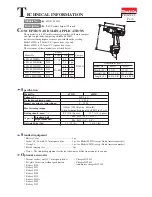
Switch action (Fig. 5)
CAUTION:
Before inserting the battery cartridge into the tool,
always check to see that the switch trigger actuates
properly and returns to the ‘‘OFF’’ position when
released.
To start the tool, simply pull the trigger. Tool speed is
increased by increasing pressure on the trigger.
Release the trigger to stop.
Reversing switch action (Fig. 6)
CAUTION:
• Always check the direction of rotation before opera-
tion.
• Use the reversing switch only after the tool comes to
a complete stop. Changing the direction of rotation
before the tool stops may damage the tool.
• When not operating the tool, always set the revers-
ing switch lever to the neutral position.
This tool has a reversing switch to change the direc-
tion of rotation. Depress the reversing switch lever
from the A side for clockwise rotation or from the B
side for counterclockwise rotation. When the revers-
ing switch lever is in the neutral position, the switch
trigger cannot be pulled.
Operation (Fig. 7 & 8)
The proper fastening torque may differ depending
upon the kind or size of the bolt. The relation between
fastening torque and fastening time is shown in the
figures.
Hold the tool firmly and place the socket over the bolt
or nut. Turn the tool on and fasten for the proper
fastening time.
NOTE:
• Hold the tool pointed straight at the bolt or nut
without applying excessive pressure on the tool.
• Excessive fastening torque may damage the bolt or
nut. Before starting your job, always perform a test
operation to verify the adequate fastening speed
and time for your bolt or nut.
The fastening torque is affected by a wide variety of
factors including the following. After fastening, always
check the torque with a torque wrench.
1. When the battery cartridge is discharged almost
completely, voltage will drop and the fastening
torque will be reduced.
2. Socket
• Failure to use the correct size socket will cause
a reduction in the fastening torque.
• A worn socket (wear on the hex end or square
end) will cause a reduction in the fastening
torque.
3. Bolt
• Even though the torque coefficient and the class
of bolt are the same, the proper fastening torque
will differ according to the diameter of the bolt.
• Even though the diameters of bolts are the
same, the proper fastening torque will differ
according to the torque coefficient, the class of
bolt and the bolt length.
4. The use of the universal joint or the extension bar
somewhat reduces the fastening force of the
impact wrench. Compensate by fastening for a
longer period of time.
5. Type of materials to be fastened, the manner of
holding the tool and the tool speed will affect the
torque.
CAUTION:
If the tool is operated continuously until the battery
cartridge has discharged, allow the tool to rest for 15
minutes before proceeding with a fresh battery.
MAINTENANCE
CAUTION:
Always be sure that the tool is switched off and the
battery cartridge is removed before carrying out any
work on the tool.
Replacement of carbon brushes (Fig. 9 & 10)
Replace carbon brushes when they are worn down to
the limit mark. Both identical carbon brushes should
be replaced at the same time.
To maintain product safety and reliability, repairs,
maintenance or adjustment should be carried out by a
Makita Authorized Service Center.
BTW120 (Eng) (’100. 11. 28)
7
Содержание BTW120
Страница 2: ...1 2 3 4 5 2 1 3 4 6 5 3 7 8 10 7 9 11 6 12 13 15 16 14 12 2 ...
Страница 69: ...69 ...
Страница 70: ...70 ...
Страница 71: ...71 ...
Страница 72: ...72 ...
Страница 73: ...73 ...
Страница 74: ...74 ...
Страница 75: ...75 ...
Страница 76: ...Makita Corporation Anjo Aichi Japan Made in Japan 884377 996 ...








































